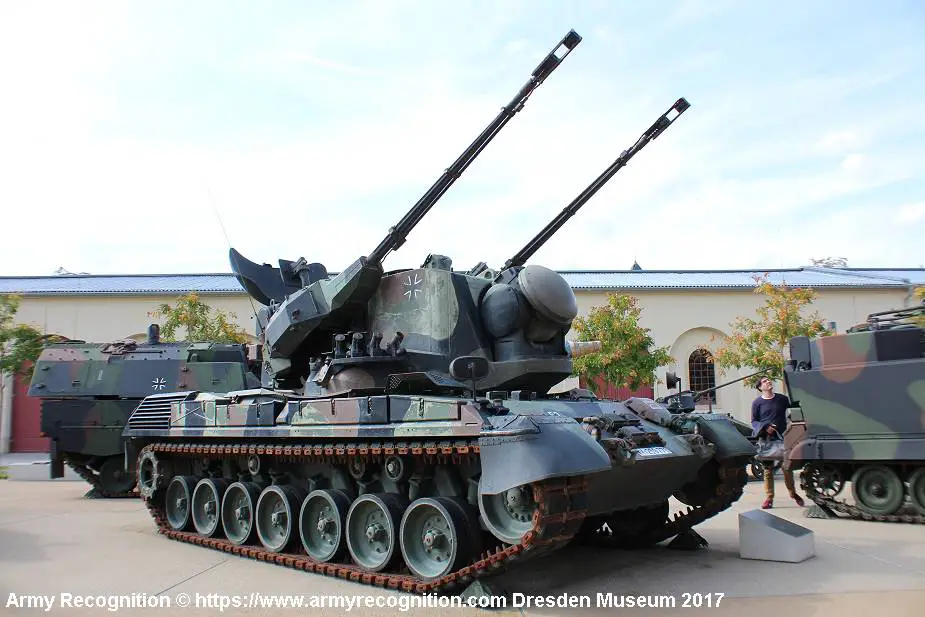According to information released by the Germany Embassy in Ukraine, Ukraine has now received 30 German-made Gepard 35mm self-propelled anti-aircraft gun systems from Germany. In fact, this air defense vehicle was developed by the German company Krauss-Maffei Wegmann (KMW) between 1976 and 1980 but continues to be effective against aerial threats including drones.
Follow Army Recognition on Google News at this link

German army Gepard 35mm self-propelled anti-aircraft gun system at Dresden Military Museum. (Picture source Army Recognition)
After the recent drone attacks by Russian forces, Ukraine continues to call on the international community to provide more weapons with air defense capabilities to counter the use of drones by Russian armed forces and missile attacks.
Russia has already acquired around 2,000 drones from Iran including Shahed-136 and Shahed-131 loitering munitions also called suicide drones. The Russian defense industry has also developed a wide range of loitering munitions such as the Lancet families which are now in service with the Russian armed forces and are widely used in the fighting in Ukraine.
A loitering munition is an aerial weapon system that is remotely controlled and used to conduct land attacks in fully or semi-autonomous mode. The great advantage of this type of weapon system, it enables faster reaction times against concealed or hidden targets that emerge for short periods without placing high-value platforms close to the target area and also allows more selective targeting as the attack can easily be aborted. Moreover, no human presence is necessary near the targets.
In September 2022, the Army Recognition editorial team reported that the Ukrainian army deployed together the Gepard and the SA-8 9K33 OSA mobile air defense missile system to provide short to medium-range air defense systems. The use of both combat vehicles offers the possibility to use SA-8 missiles for medium-range targets and the 35mm cannons of the Gepard for short-range targets such as the Russian Pantsir-S1 which is armed with cannons and missiles.
The Gepard is fitted with a two-man turret armed with two Oerlikon Contraves 35 mm KDA cannons which have a cyclic rate of fire of 550 rds/min and a maximum firing range of 5,500m. The cannons can fire a full range of ammunition including HEI (High-explosive incendiary), HEI-T (High-explosive incendiary Tracer), HEI (BF), SAPHEI-T (Armor Piercing/High Explosive/Incendiary with Tracer), FAPDS (Frangible Armor Piercing Discarding Sabot), APDS-T, APFSDS-T (Armor-piercing fin-stabilized discarding sabot with Tracer), TP/TP-T (Target Practice Tracer Projectile) and AHEAD (Advanced Hit Efficiency And Destruction).
The Gepard can search and track targets in fully autonomous mode thanks to its independent search and tracking radars. In fact, the vehicle is fitted with two radars including a pulse Doppler search radar located at the rear of the turret roof and a tracking radar mounted at the front of the turret. The radars provide 360° scanning with simultaneous target tracking, clutter suppression, search on the move capability, and a monopulse tracking mode with a range of 15 km.
In terms of mobility, the Gepard is based on the tracked chassis of the Leopard 1 main battle tank offering a high level of mobility in all-terrain conditions. can run at a maximum road speed of 65 km/h with a maximum road cruising range of 550 km and 400 km in off-road conditions. It can climb a gradient of 60 % and a vertical obstacle of 1.15m. It can cross a trench of 3 m and has a fording depth of 2.5 m.














